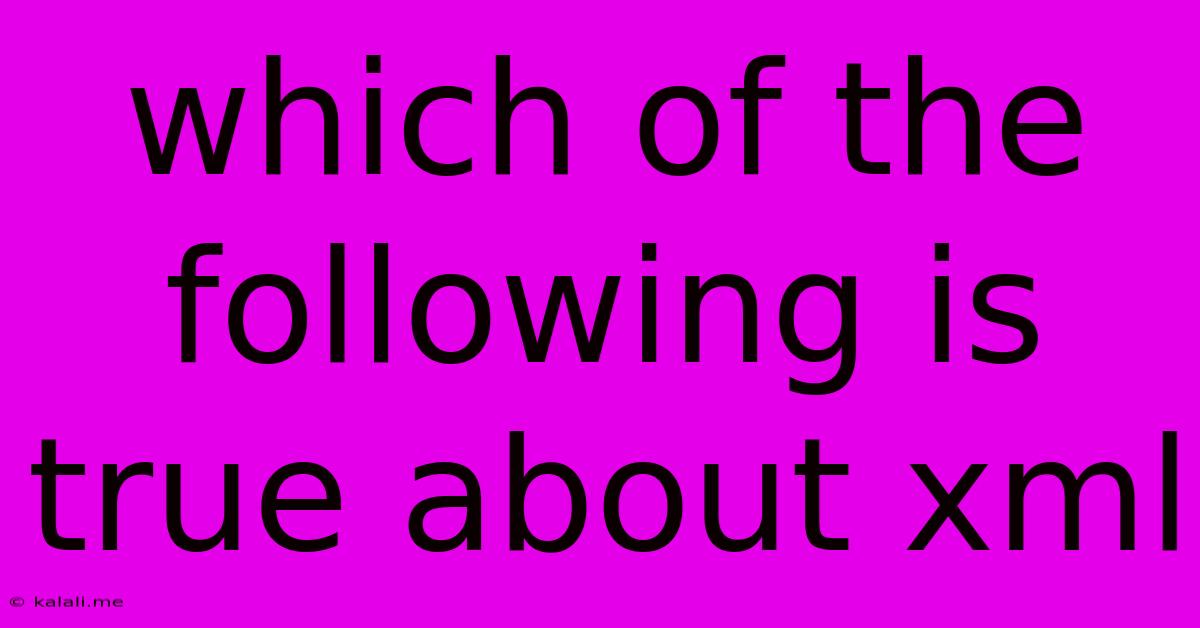Which Of The Following Is True About Xml
Kalali
Jun 12, 2025 · 3 min read

Table of Contents
Which of the Following is True About XML? Deciphering the Extensible Markup Language
XML, or Extensible Markup Language, is a cornerstone of data exchange on the web. While often confused with HTML, it serves a fundamentally different purpose. This article will explore key characteristics of XML, clarifying common misconceptions and answering the question: which of the following is true about XML? We'll delve into its structure, uses, and advantages, offering a comprehensive understanding of this powerful markup language.
What is XML? A Meta-Language for Data
Before we dive into true/false statements, let's establish a solid foundation. XML isn't a programming language; it's a markup language, meaning it uses tags to structure data. Unlike HTML, which focuses on how data is displayed, XML centers on what the data is and how it's organized. Think of it as a meta-language—a language for defining other languages tailored to specific data needs. This flexibility makes it highly versatile across diverse applications. Its primary function is to transport and store data, facilitating seamless exchange between different systems and applications.
Addressing the Common Misconceptions
Many misunderstandings surrounding XML stem from its similarities and differences with HTML. Let's address some of these before we tackle specific true/false statements:
- XML is not a replacement for HTML: HTML is for displaying data on a web page; XML is for structuring and transporting data. They can work together, with XML providing the data structure and HTML presenting it visually.
- XML is case-sensitive: Unlike HTML, XML strictly adheres to case sensitivity.
<Name>is different from<name>. - XML requires a well-formed structure: Every opening tag must have a corresponding closing tag. Improperly nested or missing tags will result in parsing errors. This ensures data consistency and integrity.
- XML supports extensibility: You can create your own custom tags, unlike HTML, which uses pre-defined tags. This customizability is a key strength, making it adaptable to various data formats and structures.
Common True/False Statements about XML
Now, let's tackle some typical true/false questions about XML:
1. XML is primarily used for displaying data on web pages. FALSE. While XML can be used in conjunction with HTML for web page display, its core function is data storage and transport, not visual presentation.
2. XML documents must follow a predefined structure. FALSE. While XML documents must be well-formed (proper nesting of tags), the specific tags used are entirely customizable, allowing for flexible data structuring.
3. XML is case-sensitive. TRUE. Unlike HTML, the capitalization of tags in XML significantly impacts the document's interpretation.
4. XML is often used for data exchange between different applications. TRUE. Its platform-independent nature and ability to structure data effectively make it ideal for communication between different systems and software applications. This is a key advantage in modern data-driven environments.
5. XML uses pre-defined tags, like HTML. FALSE. XML allows for the creation of custom tags, facilitating the creation of highly specific data structures.
Conclusion: Harnessing the Power of XML
Understanding the core principles of XML is crucial for anyone working with data exchange and web technologies. Its flexibility, robustness, and data structuring capabilities make it a powerful tool, enabling seamless data transfer between applications, systems, and platforms. By grasping the key differences between XML and HTML, and appreciating the implications of its inherent characteristics, one can effectively leverage this language for efficient data management. Remember that proper structuring and validation are essential for ensuring data integrity and efficient use of XML.
Latest Posts
Latest Posts
-
Three Phase Induction Motor Circuit Diagram
Jun 13, 2025
-
How To Subtract Two Columns In Excel
Jun 13, 2025
-
How To Print The Act Admission Ticket
Jun 13, 2025
-
The First Step In Decision Making Is To
Jun 13, 2025
-
Si Unit For Volume Of A Liquid
Jun 13, 2025
Related Post
Thank you for visiting our website which covers about Which Of The Following Is True About Xml . We hope the information provided has been useful to you. Feel free to contact us if you have any questions or need further assistance. See you next time and don't miss to bookmark.